
The tinfoil barb is a tropical Southeast Asian freshwater fish of the family Cyprinidae. This species was originally described as Barbus schwanenfeldii by Pieter Bleeker in 1853, and has also been placed in the genera Barbodes and Puntius. The specific epithet is frequently misspelled schwanefeldii.
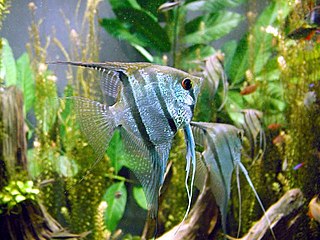
Pterophyllum is a small genus of freshwater fish from the family Cichlidae known to most aquarists as angelfish. All Pterophyllum species originate from the Amazon Basin, Orinoco Basin and various rivers in the Guiana Shield in tropical South America. The three species of Pterophyllum are unusually shaped for cichlids being greatly laterally compressed, with round bodies and elongated triangular dorsal and anal fins. This body shape allows them to hide among roots and plants, often on a vertical surface. Naturally occurring angelfish are frequently striped transversely, colouration which provides additional camouflage. Angelfish are ambush predators and prey on small fish and macroinvertebrates. All Pterophyllum species form monogamous pairs. Eggs are generally laid on a submerged log or a flattened leaf. As is the case for other cichlids, brood care is highly developed.

The term ramshorn snail or ram's horn snail is used in two different ways. In the aquarium trade it is used to describe various kinds of freshwater snails whose shells are planispiral, meaning that the shell is a flat coil. Such shells resemble a coil of rope, or a ram's horn. In a more general natural history context, the term "ramshorn snails" is used more precisely to mean those aquatic pulmonate gastropod mollusks in the family Planorbidae that have planispiral coiled shells.

The red-tailed black shark, also known as the redtail shark and redtail sharkminnow, is a species of freshwater fish in the carp family, Cyprinidae. It is endemic to Thailand and currently critically endangered, but common in aquaria, where it is prized for its deep black body and vivid red or orange tail. The red-tailed black sharks seen in the aquarium trade today are all captive bred.
Community aquaria are tanks that are designed to contain more than one species of fish. Most commonly they include a variety of species that do not normally occur together in nature, for example angelfish from Brazil, swordtails from Mexico, and gouramis from South East Asia. The aim of such communities is to bring together fish that are compatible in temperament and water requirements, while using their different colours and behaviors to add interest and entertainment value.

The dwarf gourami is a species of gourami native to South Asia.
Corydoras nanus is a tropical freshwater fish belonging to the Corydoradinae sub-family of the family Callichthyidae. It originates in inland waters in South America, and is found in the Suriname and Maroni River basins in Suriname and the Iracoubo River basin in French Guiana.
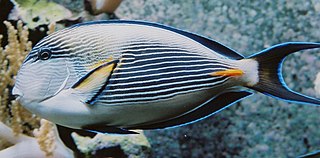
The sohal surgeonfish or sohal tang, is a Red Sea endemic which grows to 16 in (40 cm) in the wild. Its striking blue and white horizontal stripes have made it what many consider the 'poster fish' for the Red Sea reef environment. It is a valued aquarium fish.

The Siamese algae-eater is a species of freshwater fish in the carp family, Cyprinidae. This bottom-dwelling tropical fish is found in mainland Southeast Asia, including the Chao Phraya and Mekong basins as well as the Malay Peninsula. Its natural habitats are streams and rivers as well as flooded forests during the rainy season. The Siamese algae-eater should not be confused with the flying fox or the false siamensis , lacking the distinctive black bands of the former.
Algae eater, also called an algivore, is a common name for many bottom-dwelling or algae-eating species that feed on algae. Algae eaters are important for the fishkeeping hobby and many are commonly kept by hobbyists.
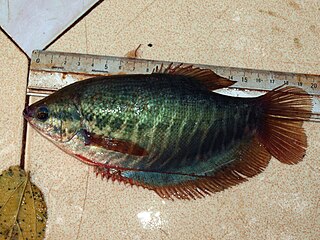
The snakeskin gourami is a species of gourami native to Southeast Asia.
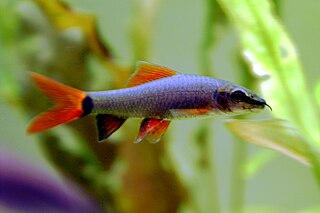
The rainbow shark is a species of Southeast Asian freshwater fish from the family Cyprinidae. It is also known as the ruby shark, red-fin shark, red-finned shark, rainbow sharkminnow, green fringelip labeo, whitefin shark and whitetail sharkminnow. It is a popular, semi-aggressive aquarium fish. Unlike true sharks, which belong to the Chondrichthyes lineage, the rainbow shark is an actinopterygiian.

The flying fox is a Southeast Asian species of freshwater fish in the family Cyprinidae. It is commonly kept in the aquarium trade. Among other foods, it is known to eat green algae. It is sometimes mistakenly referred to as the Siamese algae eater.

Epalzeorhynchos is a small ray-finned fish genus of the family Cyprinidae. Its members are – like some other cyprinids – known as "freshwater sharks" or simply "sharks". They are, however, freshwater members of the Osteichthyes lineage which is distinct from the Chondrichthyes lineage of sharks. The description of these animals as "shark" is most likely a reference to the shark-like shape of these popular cyprinids.
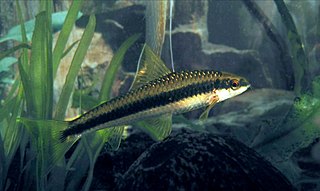
Labeoninae is a doubtfully distinct subfamily of ray-finned fishes in the family Cyprinidae of order Cypriniformes. They inhabit fresh water and the largest species richness is in the region around southern China, but there are also species elsewhere in Asia, and some members of Garra and Labeo are from Africa. They are a generally very apomorphic group, perhaps the most "advanced" of the Cyprinidae. A common name for these fishes is labeonins or labeoins.

Nematobrycon palmeri, commonly known as the emperor tetra, is a species of characid fish found in the Atrato and San Juan river basins in western Colombia. It was first imported in the aquarium trade to the United States in 1960 and has since become well established.

Gyrinocheilus aymonieri is a freshwater fish native to large parts of Southeast Asia. It is of interest as a local food source and for the aquarium trade. Its common names include honey sucker, sucking loach and Chinese algae eater; the FAO-endorsed common name is Siamese algae eater. The black line on the side of a true Siamese algae eater ends at the back of its tail fin and not the beginning.

Crossocheilus, also known as the fringe barbs, flying foxes, or "algae eaters", is a genus of fish in the family Cyprinidae. It is distributed in China, India, Indonesia, Malaysia and Thailand in Asia. These fish occur in several types of habitat, often fast-flowing rivers with rocky bottoms.

Gyrinocheilus is the single genus in the family Gyrinocheilidae, a family of small Southeast Asian cypriniform fishes that live in fast-flowing freshwater mountain streams. The species in this genus are commonly called "algae eaters." They hold on to fixed objects using a sucker-like mouth, and, despite the name, feed on a wide range of detritus, rather than simply on algae. A "golden" variety of G. aymonieri, the Chinese algae eater or "sucking loach", can be found in many pet shops and fish farms.
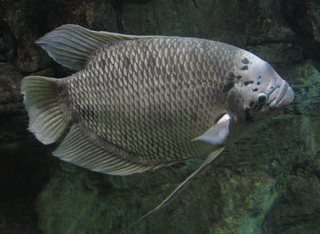
The giant gourami is a species of large gourami native to freshwater habitats in Southeast Asia, with its occurrence in other locations due to introductions. This species is commercially important as a food fish and is also farmed. It can also be found in the aquarium trade. The species has been used for weed control, also on highly invasive aquatic plants like Salvinia molesta, as the giant gourami can be a voracious herbivore.
















